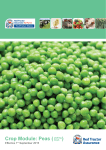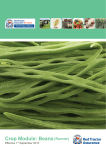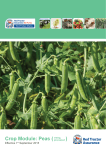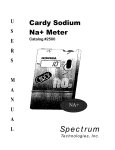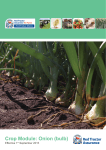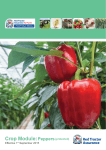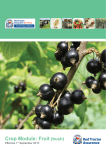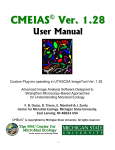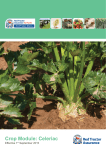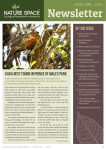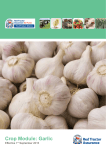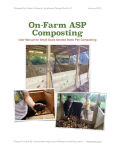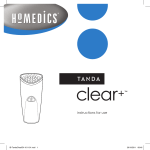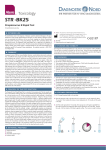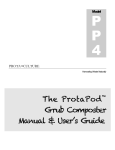Download Crop Module: Beans( ) - Red Tractor Assurance
Transcript
Crop Module: Beans ( broad, fresh ) Effective 1st September 2015 Welcome T his crop specific module for broad beans has been written to complement and avoid duplicating the generic principles of the Red Tractor Farm Assurance Fresh Produce Scheme standards. It is advisable to read the Red Tractor Farm Assurance Fresh Produce standards before reading this crop specific module. This module is designed to stimulate thought in the mind of the reader. It contains crop specific guidance and standards, where applicable, in addition to the requirements stated in the generic Fresh Produce standards. Within this module the important requirements outlined in the crop specific standards section will be verified during the Red Tractor Farm Assurance assessment and compliance will form a part of the certification/approval decision. Disclaimer and trade mark acknowledgement Although every effort has been made to ensure accuracy, Assured Food Standards does not accept any responsibility for errors and omissions. Trade names are only used in this module where use of that specific product is essential. All such products are annotated® and all trademark rights are hereby acknowledged. Notes: Pesticide Information General Introduction Following a systematic approach will help growers identify and manage the risks involved in crop production. This module is based on a typical crop production process and food safety, health & safety, environmental and quality hazards are identified. Appropriate controls may then be established to minimise risk. Food safety and health & safety issues always take precedent over quality and environmental controls. The layout of this module follows the same structure as that used in the Red Tractor Farm Assurance Fresh Produce Standards. The content of the module is reviewed prior to the issue of updated editions. The review process considers both new developments and all relevant technology which has emerged since the last review was completed and which have been found to be both workable by the grower and beneficial to the environment. The aim is to transfer such information and technologies to growers. Acknowledgements Red Tractor Farm Assurance Fresh Produce gratefully acknowledges the contribution of all consultees in the preparation of this protocol, particularly Anthony Biddle and Becky Ward of the Processors & Growers Research Organisation and Cathy Knott. The Red Tractor Fresh Produce team has been working with Fera to provide tailored access to the LIAISON database for all Red Tractor Fresh Produce members. This system allows individual growers access to all information for plant protection products approved for use under the Red Tractor Fresh Produce Scheme. LIAISON can be accessed under the Produce tab via the “Checkers and Services” page where you will also find a user manual. Searches will be filtered specifically for the crops for which you are registered. Once you have logged onto the site and clicked on the LIAISON hyperlink you will be directed to the LIAISON home screen. You will need a username and password and these will be sent once you have registered: http://assurance.redtractor.org.uk/rtassurance/ services/Registration/members.eb . 1 Red Tractor Assurance for Farms – Crop-specific Module: Beans (broad, fresh) © Assured Food Standards 2015 Content Contents ADDITIONAL REQUIREMENTS AGAINST CURRENT STANDARDS 02 CROP SPECIFIC STANDARDS02 CHOICE OF VARIETY, ROOTSTOCK AND PLANT HEALTH CERTIFICATION03 SITE AND SOIL MANAGEMENT 03 ENVIRONMENTAL PROTECTION AND CONTAMINATION CONTROL03 NUTRITION 07 IRRIGATION07 RESIDUES AND CONTAMINANTS07 APPENDIX 1: TYPICAL APPLICATION RATES FOR NUTRIENTS 08 ADDITIONAL REQUIREMENTS AGAINST CURRENT STANDARDS None for this crop module CROP SPECIFIC STANDARDS STANDARDS HOW YOU WILL BE MEASURED CQ.62.a n Perennial Weeds must be controlled to prevent yield loss and ensure ease of picking RECORDS (to be kept for 2 years) grasses are eradicated with an application of glyphosate in autumn before sowing broad beans n Weeds that have not been eliminated by cultivations are killed, prior to sowing, with non-selective herbicides (e.g. glyphosate) n Potatoes CQ.62.b Growers must adopt a policy for reducing volunteer problems for oilseed rape and potatoes are not ploughed down after the harvest, as this aids their survival. Potatoes left on or near the surface are likely to be affected by frosts or eaten by animals Red Tractor Assurance for Farms – Crop-specific Module: Beans (broad, fresh) © Assured Food Standards 2015 2 GUIDANCE CHOICE OF VARIETY OR ROOTSTOCK AND PLANT HEALTH CERTIFICATION ENVIRONMENTAL PROTECTION & CONTAMINATION CONTROL VARIETY SELECTION The guiding principle is that pesticide use should be minimised. An integrated approach should be adopted to achieve this involving the following management steps. Continuity of cropping is achieved with the use of varieties with maturities from early and late, but more often using one variety and sequential sowings based on accumulated heat units or on observations of seedling development. SITE AND SOIL MANAGEMENT SITE HISTORY Climate Broad beans can be grown successfully in most parts of the UK but high rainfall leads to excessive vegetative growth and drought stress during flowering and pod fill stages reduces yield. Crop rotation Crop rotation is essential to prevent the build-up of pests and diseases. Several soil-borne fungi can infect broad beans and peas as well as field beans and green beans. Pea cyst nematode can also be increased if broad beans and peas are grown in the rotation. All beans and peas should be treated as one and the same crop and not grown more frequently than once in five years. Soil type Broad beans have a strong taproot, withstanding adverse soil conditions better than peas and can, therefore, be grown on heavier soil types. Sowing Broad beans have a large flattish seed so only a belt feed and certain vacuum precision drills are suitable or they may be hand sown. THE BASIC APPROACH TO CROP PROTECTION PLANNING a. sensible crop rotations to avoid build-up of problems b. careful site selection to avoid potential or previous problems thereby enhances crop health and cleanliness c. inclusion of resistant varieties in cropping programmes whilst retaining the required quality parameters and eating characteristics. Cultural preventative techniques a. good crop and field hygiene b. promoting crop health by ensuring effective nutrient availability through soil analysis and accurate application of fertilisers and trace elements c. utilising available irrigation to promote healthy growth and as a control measure wherever appropriate and feasible. Corrective action Where corrective or protective action is necessary the following approach should be adopted: a. The need to take corrective or protective action must be established by regular monitoring and reference to established thresholds. The effect of prevailing and predicted weather conditions on the need for treatments must be considered b. The availability and use of biological and natural methods of pest and disease control must be reviewed and applied if appropriate. c. Where chemical control is essential: n Broad beans are dependent on insects, for example bees, for pollination. Pesticides classed as harmful, dangerous or extremely dangerous to bees must not be used when broad beans are in flower. 3 Red Tractor Assurance for Farms – Crop-specific Module: Beans (broad, fresh) © Assured Food Standards 2015 n The least toxic and persistent product should be selected with due regard to its efficiency and ecotoxicity. n The minimum effective dose should be used. n An appropriate application method with effectively maintained equipment should be chosen. n Selective and spot treatments should be used whenever appropriate. PEST CONTROL Pea and bean weevil (Sitona lineatus) Weevil feed on the leaves and cause semi-circular notches around the leaf margins. Adults migrate to beans from their overwintering sites mainly in early spring when the maximum air temperature exceeds 12°C. Eggs are laid by the adults and washed into the soil, where the larvae hatch and feed below ground on the nitrogen-fixing root nodules. Newly emerged seedlings are more prone to weevil injury in the spring, but autumn-sown beans are usually too advanced to suffer any significant damage. Chemical control: Where weevils are known to be an annual problem, an insecticide applied to newly emerged seedlings at the first sign of leaf notching, particularly after a few warm days, will reduce further leaf injury and interrupt egg laying. It is not worthwhile treating autumn sown broad beans. Cultural control: Avoid producing cloddy seedbeds that are preferred by the weevils. Good soil conditions will allow rapid germination and emergence of the crop increasing the chances of growing away quickly from attack. Later sown crops are less likely to be severely attacked. A monitoring system is available from Agralan Ltd, Ashton Keynes, Swindon. Stem and bulb nematode (Ditylenchus spp.) Damage is often first seen as the plants reach the flowering stage. Plants are stunted with thickened, twisted stems. Leaves may be thickened and brittle with discolouration occurring in the leaf petioles. Stems may discolour and break and pods fail to fill evenly and seeds are poorly developed or discoloured. Chemical control: The nematodes can survive in the soil for several years, but no chemicals are approved for control in the soil. Cultural control: Nematodes can be seed-borne and all seed should be tested for the presence of the pest and discarded if found. The pest can infest new land and so an adequate rotation will help to prevent build-up in the soil. When established in a crop, the produce should not be used for seed and a break of at least ten years should be left before returning to beans (field and broad). A seed test is available from Processors and Growers Research Organisation or NIAB. Black bean aphid (Aphis fabae) Dense colonies of black aphid can develop at any time on the upper part of the stem from the onset of flowering. Damage occurs mainly as a direct effect of feeding and pods can be blemished. In addition both black bean aphid and pea aphid can transmit viruses such as bean leaf-roll virus. Chemical control: Black bean aphids and pea aphids are relatively easy to control, but the choice of insecticides should be limited to those which will not harm pollinating insects. When 10% of the plants are colonised, spraying should be carried out as soon as possible (See BLRV). The most effective timing of sprays is at early flower. Cultural control: Small areas of beans may be “topped” at the end of flowering to reduce aphid infestation later in the season. Autumn planted beans may mature earlier than the migration of aphid from their overwintering sites and treatment is unnecessary. The presence of thistles or fat hen in the crop can encourage aphid infestation. Bean seed beetle (Bruchus rufimanus) The damage is caused by the larvae of the beetle that feed inside the developing beans within the pod. Adult beetles are black, oval in shape, 3.5-4.5mm long with ridged wing cases that do not cover the abdomen. Eggs are laid on young pods and the larvae burrow down through the pod and into the seed. They are creamy white, with a dark head, and the legs are not obvious to the naked eye. The presence of the pest is not detected until after the beans have been shelled. If allowed to mature to seed in the field, the larvae pupate within the seed and bite their way out leaving a circular hole. Chemical control: Flowering crops should be examined for the presence of adults by tapping the flowering stems into the hand or a small flat box. Insecticide should be applied in 100-200l/ha of water if adults are found when the first pods have begun to set on the lowest truss and temperatures have reached at least 20ºC for 2 consecutive days. Angled nozzles will help crop penetration by the spray. A second spray should be applied 7 days later. Beekeepers should be warned before applications are made. Cultural control: The beetles fly to beans during flowering from overwintering sites adjacent to the previous year’s field bean crops. Avoid planting beans near to such areas. Red Tractor Assurance for Farms – Crop-specific Module: Beans (broad, fresh) © Assured Food Standards 2015 4 DISEASE CONTROL Foot rot (Fusarium solani f. sp. viciae / Fusarium culmorum) Individuals or groups of plants are stunted, the foliage becomes progressively chlorotic and wilting is followed by premature leaf fall and death. The stem base is blackened and decayed and the root system is severely restricted and discoloured. Chemical control: There are no chemicals available to control foot rot in beans. Approved seed treatments are inadequate to reduce infection. Cultural control: Spring sown beans are particularly susceptible especially in consolidated soil which can cause a moisture stress in dry summers. An adequate rotation is necessary to avoid the build-up of fungi in the soil. Avoid adverse soil conditions and grow beans only on well-drained soils. Downy mildew (Peronospora viciae) Severe infection can reduce flower numbers, cause defoliation and death of the growing point. Early symptoms appear as pale areas on the upper surface of the leaves. The lesions become grey and necrotic at the centre with paler green zones at their margins. The underside of the lesions is grey-brown becoming a greyish-mauve with a velvety fungal growth. If the growing points become infected, the whole leaves appear pale and are covered with the light grey downy growth of the fungus. Chemical control: The development of downy mildew should be monitored and fungicide applications only made where they can be justified. A fungicide should be applied at early flowering when symptoms are first seen on about 25% of the plants. The disease is more likely to develop rapidly at temperatures below 10°C in the seven days prior to flowering if leaves have been wet for longer than 12 hours. A repeat spray may be necessary 10-14 days later if the disease develops later on, particularly during humid weather. If mildew infects the upper leaves after all the pods have set, treatment is not worthwhile. Where the disease occurs regularly, some control of seedling infection can be provided by Wakil XL seed treatment. Cultural control: The disease is soil-borne and spreads within the crop by means of air-borne spores. Avoid planting beans on fields where there is a known history of downy mildew. Later sown crops tend to be more susceptible to mildew as they are less well developed at the time that air-borne spores enter the crop. Autumn planted beans seldom suffer damaging attacks. 5 Chocolate spot (Botrytis fabae / Botrytis cinerea) Symptoms may show in autumn planted crops from late February onwards when the first ‘non-aggressive’ lesions develop on the lower leaves. They are reddish brown and vary in size from small dots to rounded sunken spots 1-2mm in diameter. During May and June, if weather is wet, the disease develops on all of the leaves and the disease becomes ‘aggressive’ to form larger grey-brown blotches. On the stem, reddish brown streaks occur and the pod surfaces may be discoloured and pitted. Spring sown crops may develop the disease from mid-flowering onwards. Chemical control: The development of chocolate spot should be monitored and fungicide applications only made where they can be justified. Autumn sown beans should be sprayed with a fungicide as soon as the beans produce the first flowers when disease lesions can be seen on the lower leaves. A second application may be necessary 3-4 weeks later. In spring beans, a spray at early to mid-flower may be necessary if spotting is present on the bottom half of the plants. A second spray may be applied 2-3 weeks later if necessary. Cultural control: Chocolate spot is favoured by wet conditions or high humidity together with low light intensity. High plant population should be avoided. Beans that are under stress are also susceptible. Ascochyta leaf and pod spot (Ascochyta fabae = Didymella fabae) The disease is primarily seed-borne but air-borne spores can spread from local infected broad or field bean crops or volunteer beans and beans develop symptoms shortly after the first leaves have expanded. Brownish grey circular lesions 3-5mm in diameter appear in the leaves and stems. These can then enlarge and spores are splashed by rain onto surrounding plants. Deep brown lesions develop on the pod making them unmarketable. The disease is usually more serious in autumn sown beans as the wetter period in the winter is more favourable for disease spread. Chemical control: Seed treatment, containing fludioxonil (Wakil XL), is only partially successful in controlling Ascochyta in the seed. Most fungicides applied for chocolate spot or downy mildew control have little effect on Ascochyta, although trials have shown that azoxystrobin can reduce foliar infection Cultural control: Use only healthy seed. Seed should be tested for the presence of Ascochyta fabae. Site autumn sown beans away from winter field bean crops or where field bean volunteers may be present to reduce the risk of spread by air-borne spores in the winter and spring. Avoid planting spring sown beans adjacent to an infected autumn crop. Red Tractor Assurance for Farms – Crop-specific Module: Beans (broad, fresh) © Assured Food Standards 2015 Rust (Uromyces fabae) Spring sown beans are more likely to suffer infection of rust. Small white to orange dots surrounded by a thin pale yellow halo appear on the leaves. Later the dots develop as orange brown pustules, sometimes occurring in rings and release brown spores as a dust. The pustules can develop on the stems. Yield can be severely affected as the plant can defoliate before pods are completely filled. Chemical control: For control apply tebuconazole or metconazole as soon as rust pustules are seen. If rust appears after pod fill, the yield is not significantly affected. Azoxystrobin will also suppress rust. Cultural control: Rust is favoured by hot dry conditions with humid nights. Late sown crops are more susceptible to infection. Bean leaf roll virus (BLRV) / Pea enation mosaic virus (PEMV) Black bean aphid and pea aphid transmit both viruses. The leaves display interveinal yellowing and BLRV predisposes the plant to chocolate spot. PEMV produces a mosaic pattern on the leaves. Individual or small groups of plants are infected coinciding with earlier aphid infestation. Control: As for aphids. Broad bean stain virus (BBSV) Leaf symptoms include a mottling with light and dark green areas visible on the surface. Some leaf distortion may occur. The main effect of the virus is on the produce, which displays a dark brown coloured area around the periphery of the seed. Chemical control: The virus is seed-borne, but can be transmitted to neighbouring plants by the pea and bean weevil and clover seed weevil. Such transmission however, may be low and specific control measures are unnecessary. Cultural control: The health of new seed has been generally good, but care should be taken with homesaved seed particularly if used repeatedly over several years. The use of new seed at regular intervals is likely to prevent infections from virus-infected seed. WEED CONTROL Inter-row cultivations can be used since the crop is normally grown in wide rows. However cultivations will usually stimulate another flush of weeds. Herbicides A few residual pre-emergence herbicides for broadleaved weeds are available for the broad bean crop, but only one, bentazone, is approved for post-emergence use and the weed spectrum it controls is limited. Most broad beans are treated with a residual herbicide provided the soil type is suitable. Problem weeds Growers must adopt a policy for reducing volunteer problems for oilseed rape and potatoes by using appropriate husbandry practices after harvest of these crops. Thistles and volunteer potatoes can cause severe problems in broad beans and it is not possible to control them with herbicides. Thistles interfere with picking. Every attempt should be made to control them in other crops in the rotation. After the potato harvest, do not plough down any remaining tubers as this aids their survival. Potatoes left on or near the surface are likely to be affected by frosts or eaten by animals. APPROVED USES NOT INCLUDED ON THE PRODUCT LABEL In many circumstances, particularly for minor crops, product labels do not include all of the approved uses and growers wishing to check the approval notice of a particular product should note that this information is available using the LIAISON® search accessible via their Red Tractor Farm Assurance home page after logging in. A search on the ‘Specific Off-Label Approvals’ page of LIAISON® by crop or product name should yield a results page. A click on the product name should link to a summary of the approval information. Near the bottom of the summary is the specific off-label (now known as EAMU’s) number (e.g. 0246/09) and this link will open up a pdf of the current EAMU document giving details of the extension of use. Weeds should be controlled to prevent yield loss and ensure ease of picking. The most effective means of eradicating perennial grasses is with an application of glyphosate in autumn before sowing broad beans. Weeds that have not been eliminated by cultivations can be killed, prior to sowing, with non-selective herbicides (e.g. glyphosate). Red Tractor Assurance for Farms – Crop-specific Module: Beans (broad, fresh) © Assured Food Standards 2015 6 NUTRITION MAJOR NUTRIENTS Prior to cropping the field, nutrient status should be determined by soil sampling and analysis. Fertiliser application should be in accordance with crop needs and soil reserves (see Appendix). The nitrogen-fixing Rhizobia bacteria that are responsible for root nodulation of broad beans occur naturally in UK soils and supply broad beans with their nitrogen requirement. Applications of nitrogen fertiliser, farm manure or advanced treated sewage sludge are unnecessary and will delay and suppress nodulation. If broad beans show symptoms of nitrogen deficiency this may be due to destruction of root nodules, for example, in conditions of waterlogging. Applications of nitrogen fertiliser will not be effective because a damaged root system is unable to take up nitrogen. Phosphate and potash are applied as a base fertiliser before cultivation. Examples of typical fertiliser recommendations are given in RB209 2011 version. IRRIGATION Broad beans are very sensitive to drought stress and are responsive to irrigation. Scheduling systems help to forecast the timing and priority order. Broad beans are most sensitive to soil moisture deficits from the beginning of flowering onwards and irrigation can achieve large yield increases. There is no information available regarding possible increases in diseases such as chocolate spot (Botrytis fabae). RESIDUES AND CONTAMINANTS Red Tractor Farm Assurance Fresh Produce is aware that a key area in the production of fresh produce which requires continued attention by growers and their advisers is that of keeping pesticide residues to a minimum. This issue is not just one of meeting the MRL trading standard but ensuring that any individual or multi residues are kept as low as possible below this level. The key targets are: n Optimising late applications of fungicides insecticides to the edible part of the crop Lime and pH n Optimising Broad beans require a pH of at least 6.0 to 6.5. If the pH is below 5.5 growth will suffer and an application of lime will be needed. Over-liming should be avoided as it can induce deficiency of trace elements such as manganese. n Ensuring Trace elements Treatments should only be applied where a deficiency problem has been identified. and the use of post-harvest treatments minimum harvests intervals are followed n Ensuring that application equipment is applying products correctly Currently there are no residue issues associated with this crop but awareness needs to be maintained for any future issues. Manganese deficiency is less common in broad beans than peas. Symptoms are chlorosis between veins and round margins of the leaves. Occasionally marsh spot disorder, a necrotic spot that appears on the cotyledons occurs in broad beans. It occurs where the soil is deficient or if manganese is unavailable to the plant and is associated with peaty organic soils and sandy soils with pH over 6.8. Soil analysis for manganese, however, is of little value. It is corrected by foliar sprays of manganese sulphate + wetter. Magnesium deficiency symptoms are interveinal chlorosis or necrosis of older leaves with leaf margins remaining green. The older leaves are affected first. It is uncommon but may occur on sandy acid soils or where there is excess potash. Soil analysis will identify where there is a problem. At index 0 keiserite may be applied and if liming is also necessary, it can be corrected with magnesian limestone (see Appendix), either before broad beans or elsewhere in the rotation. If crop treatment becomes necessary, corrective foliar sprays with magnesium sulphate should be applied. 7 Red Tractor Assurance for Farms – Crop-specific Module: Beans (broad, fresh) © Assured Food Standards 2015 APPENDIX 1: TYPICAL APPLICATION RATES FOR NUTRIENTS Major nutrient requirements (kg/ha) (Source: Defra Fertiliser Manual RB209) Nutrient (kg/ha) Soil Index 0 1 2 3 3+ Phosphate (P2O5 ) 200 150 100 50 0 Potash (K2O) 200 150 0 0 Magnesium (1) (MgO) 100 50 0 0 Notes: (1) Magnesium is not necessary for every crop and can be applied elsewhere in the rotation as magnesian limestone on acid soils. The total quantity of fertiliser required should be applied to the seedbed. 100(2-) 50(2+) 0 You should not apply fresh solid manures and slurries within 12 months of harvest, subject to there also being a minimum of 6 months between application and sowing. Untreated or digested sewage sludge must not be applied within the crop rotation. These recommendations for P + K are very high and are to build up soil nutrients in a vegetable rotation. Where there is no plan to raise the soil index level, the recommendations may be reduced by 150kg/ha at index 0, 100kg/ha at index 1, and 50kg/ha at index 2-. Only advanced treated sewage sludge may be used within the crop rotation and it must not be applied within 10 months of harvest. Applications shall be carried out in accordance with the Regulations and the current Defra Code of Practice for the Agricultural Use of Sewage Sludge. Consult your retailer before using FYM. PGRO technical publications The guidelines in ‘Managing Farm Manures for Food Safety: Guidelines for Growers to Minimise the Risks of Microbiological Contamination of Ready to Eat Crops’ should be followed (http://www.food.gov.uk). Copies of various publications on pea and bean production, herbicides and pesticides are available to PGRO levy payers from: Broad beans sold fresh are classed as “Ready to Eat” crops - i.e. they can reasonably be expected to be eaten without any further processing to reduce microbial contamination, other than by washing. Select fields carefully to avoid risk of indirect contamination via surface run-off from manure heaps or stores, and during or following spreading of manures on the land. Ensure water sources used on the farm are not contaminated with manures or run-off. Treated or batch stored solid manures and slurries can be applied before sowing. Processors and Growers Research Organisation The Research Station Great North Road Thornhaugh Peterborough PE8 6HJ Tel: 01780 782585 Web: www.pgro.org Technical updates are downloadable from the website at www.pgro.org Red Tractor Assurance for Farms – Crop-specific Module: Beans (broad, fresh) © Assured Food Standards 2015 8 NOTES 9 Red Tractor Assurance for Farms – Crop-specific Module: Beans (broad, fresh) © Assured Food Standards 2015 Certification Bodies Your routine point of contact with the Scheme is through your Certification Body. Certification Bodies are licensed by Red Tractor to manage membership applications and to carry out assessment and certification against the Standards. The table below shows which Certification Bodies apply to each enterprise. Certification Body NSF Kiwa PAI SAI Global SFQC Beef and Lamb Dairy Combinable Crops and Sugar Beet Fresh Produce 4 4 4 4 4 4 4 4 4 4 4 4 4 4 4 4 NIFCC (Northern Ireland) 4 QWFC (Wales) 4 Pigs Poultry 4 4 4 4 4 4 4 NSF Certification Kiwa PAI Hanborough Business Park Long Hanborough Oxford OX29 8SJ Tel: 01993 885739 Email: [email protected] Web: www.nsf-foodeurope.com The Inspire, Hornbeam Square West, Harrogate, North Yorkshire HG2 8PA Tel: 01423 878878 Email: [email protected] Web: www.kiwa.co.uk/pai SAI Global Assurance Services Ltd PO Box 6236, Milton Keynes MK1 9ES Tel: 01908 249973 Email: [email protected] Web: www.saiglobal.com/assurance QWFC SFQC Ltd NIFCC [Northern Ireland] QWFC [Wales] Royal Highland Centre, 10th Avenue, Ingliston, Edinburgh EH28 8NF Tel: 0131 335 6605 Email: [email protected] Web: www.sfqc.co.uk Lissue House, 31 Ballinderry Rd, Lisburn, Northern Ireland BT28 2SL Tel: 028 9263 3017 Email: [email protected] Web: www.nifcc.co.uk PO Box 8, Gorseland, North Road Aberystwyth SY23 2WB Tel: 01970 636688 Email: [email protected] Web: www.wlbp.co.uk T: 01932 589 800 E: [email protected] www.redtractorassurance.org.uk Fresh Produce Standards












